
By Tal Ridnik
Training regimes, regularization schemes, and architecture enhancements are crucial for effective deep learning. We shall name them "Dark Magic Tricks". In this article, we review useful dark magic tricks, accompanied by examples and use-cases. We also compile a generic "checklist" of tricks testing, that can be used to upgrade any existing deep learning repository.
Dark magic tricks are usually not fully supported by deep mathematical background but are more empirically and heuristically based. Due to that, in many cases they are overlooked and briefly mention as implementations details in academic articles, sometimes even visible only by inspecting source codes.
The lack of fundamental understanding and the heuristic nature of these tricks, in addition to their importance and effectiveness, is the reason we named them "Dark Magic".
Despite the relative disregarding, we argue that the difference between mediocre and top repositories is almost always due to better dark magic tricks. Even for articles that claim to reach new SotA scores using a unique novelty, in almost all cases the novelty is accompanied by very effective usage of existing dark magic tricks.
There is no trick that always works, and has "correct" hyper-parameter values. You usually need to choose the relevant tricks for each problem and tune their hyper-parameters. However, knowing and understanding common best practices can increase dramatically the chance to use dark magic tricks effectively and get top scores.
We have compiled a generic checklist of dark magic tricks and best practices, that we try and test each time we start a new repository or upgrade an existing one. For each checklist trick, we always try to recommend a specific default option, instead of suggesting a long list of possibilities. Each recommendation is accompanied by example and uses cases that were thoroughly tested and reviewed. While our main focus was on classification datasets, we believe that our checklist has a good chance to generalize to other tasks and datasets.
Training Schemes:
Regularization Tricks:
Architecture Enhancements:
While we, of course, can't cover all the existing dark magic tricks, we found the checklist above very useful and were able with it to improve our scores significantly on multiple datasets - CIFAR10, CIFAR100, ImageNet, Palitao-102K, Alicool, COCO keypoints, Market-1501, SVHN, Freiburg-grocery and more. In the following sections, we will dive in and analyze the different tricks on the checklist.
Due to space considerations, tricks marked with (-) are left for future posts.
We experimented a lot with different kinds of learning rate regimes, including gamma decay, cosine annealing, heuristics ("reduce learning rate by factor 0.1 in epochs 50 and 75...") and more.
We found that the learning rate regime which is the easiest to tune and generalize best to multiple datasets is "Cosine power annealing", that can be seen as an average between cosine annealing and gamma decay via a control parameter P:

P permits tuning of the curves decay rate such that it maintains a high learning rate for the first few epochs, while simultaneously taking a shallower slope during the final third of epochs. We usually choose P=2 or P=4.
We also found that given a fixed number of epochs, repeated cycles of cosine power annealing with decaying amplitude gave us better test scores than a single cycle. Another advantage of repeated cycles is that during the training we get improving estimations for the final accuracy.
Finally, we found that a small warm-up duration stabilizes our training and enable us to use a larger initial learning rate, which accelerates the convergence.
To conclude, the learning regime we found that works best on multiple datasets is cycles of cosine power annealing, with decaying amplitude and initial warm-up, as presented in the following graph:
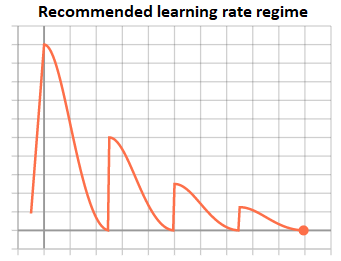
Comparing cycles of power cosine against simple gamma decay and cosine annealing will sum up to 3 trials.
Currently, most top deep learning repositories are using simple SGD with momentum optimizer, instead of fancier optimizers like ADAM or RMSProp, mainly because SGD uses less GPU memory and has significantly lower computational cost.
For multiple datasets, we found that SGD with Nesterov-momentum outperforms plain SGD with momentum optimizer while having the same GPU memory consumption and a negligible additional computational cost. An example from ImageNet testings:
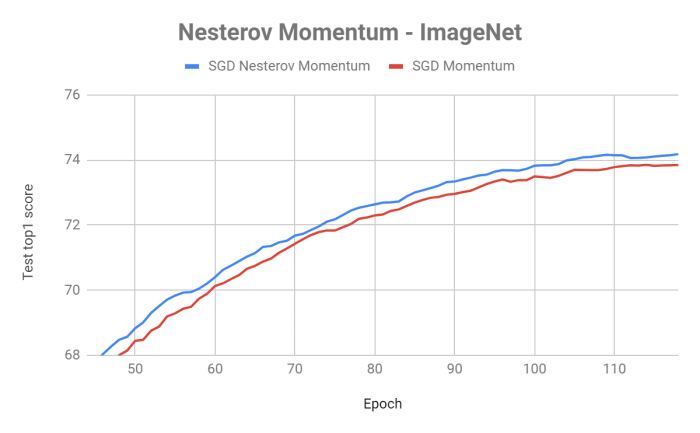
Hence we recommend using SGD with Nesterov momentum optimizer as the default option for deep learning training. Comparing Nesterov momentum to regular SGD with momentum and ADAM optimizers will sum up to 3 trials.
A widespread practice for computer vision deep learning is to pretrain a model on ImageNet.
While this approach showed great success in the past, it was usually used on large models like ResNet or Inception, that contain tens of millions of parameters.
Nowadays, there are many models with comparable performances to ResNet, but with an order of magnitude fewer parameters, such as MobileNet, ShuffleNet, and XNAS.
We found that when training these smaller models on different datasets, pretraining on ImageNet may hurt the performance significantly, as this example on COCO keypoint detection dataset shows:
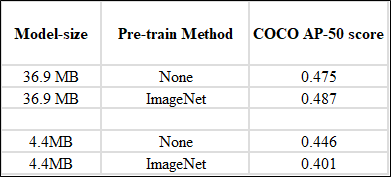
Hence our recommendation is to consider carefully the effectiveness of pretraining a model on ImageNet, especially for small models.
Comparing training without and with ImageNet pretraining will sum up to 2 trials.
AutoAugment is a seminal work where learned augmentations replaced standard color augmentations. Three AutoAugment policies were learned, for the datasets: CIFAR10, ImageNet and SVHN.
When using these policies, we were able quickly to reproduce the article results and get an improvement over standard color augmentations
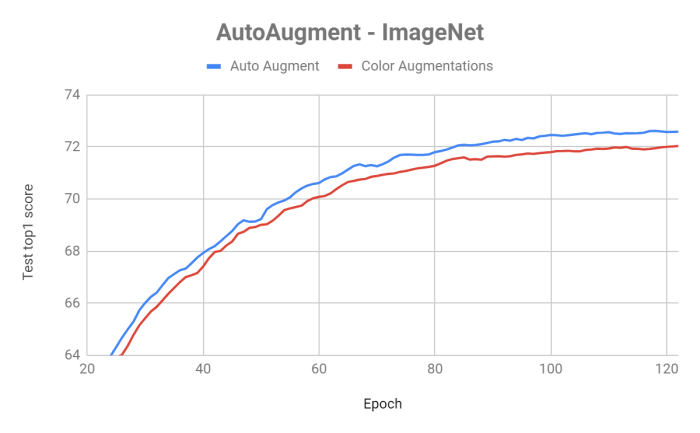
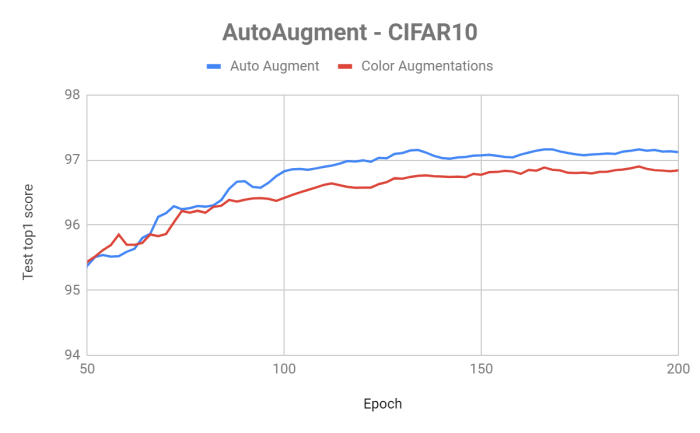
However, what about other datasets, where no specific policy of AutoAugment was learned?
We advise against trying to learn dedicated augmentations regimes for your dataset since it requires a substantial amount of GPU hours and extensive tuning of hyper-parameters, which can take weeks over weeks. Notice that newer works that claim to learn augmentation policies faster studied exactly the same datasets as the original AutoAugment article.
Instead of trying to learn a tailor-made augmentation regime for your datasets, we suggest using existing AutoAugment policies. Here are results we got for Freiburg-groceries and Alibaba-internal Palitao-102K datasets:
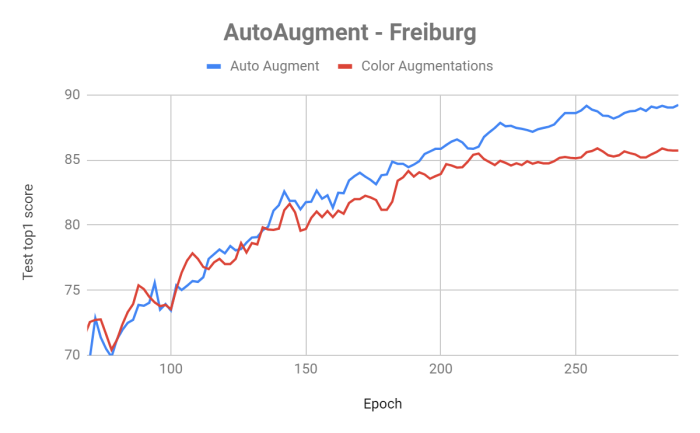
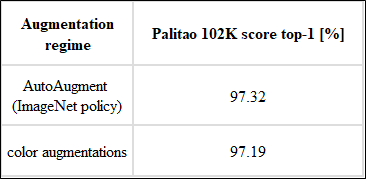
Hence we recommend trying using AutoAugment existing policies instead of plain color augmentation.
Comparing AutoAugment (preferable ImageNet policy) to standard color augmentations will sum up to 2 trials.
While mentioned in every beginner's deep learning course, weight decay does not receive the attention it deserves among regularization techniques. Most repositories don't seem to invest lots of effort in optimizing the weight decay, and just use a generic value, usually 5e-5 or 1e-5.
We argue that weight decay is one of the most influential and important regularization techniques. Adjusting the weight decay is crucial for obtaining top scores, and the wrong value of weight decay can be a major "blocker".
For example, here are tests we did to optimize weight decay on ImageNet and CIFAR10:
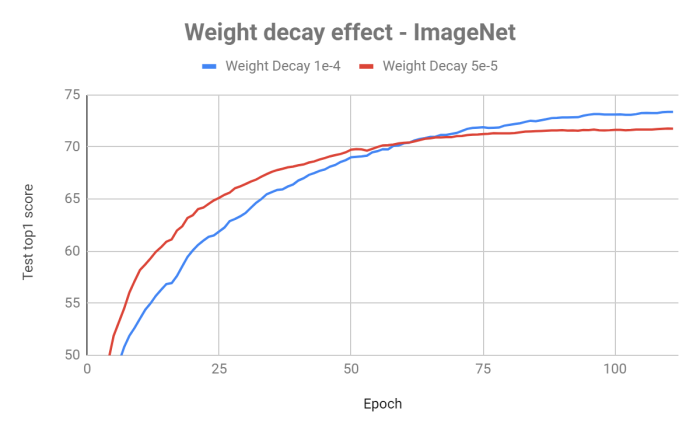
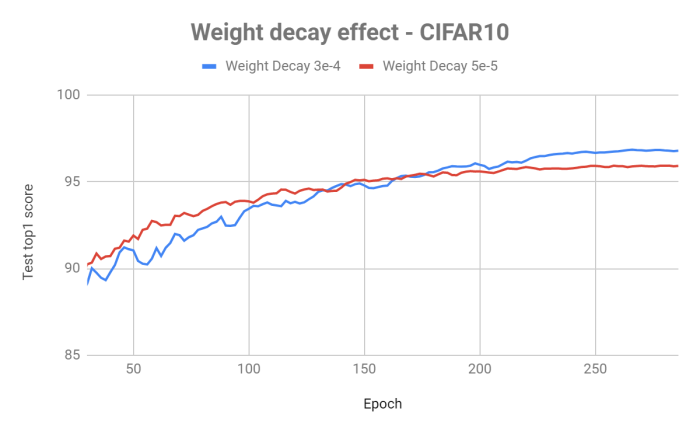
We can see that for both datasets optimizing the weight decay gave a significant boost to the test score.
Hence we recommend optimizing weight decay instead of using a generic value.
We suggest testing at least 3 values of weight decay, a "generic" value (~5e-5), bigger weight decay and a smaller one, summing up to 3 trials. If significant improvement is seen, do more tests.
Label smoothing is an important classification training trick that appears in most repositories, usually with a default smoothing value of 0.1, which people rarely change.
With label smoothing, we edit the target labels to be:
target = (1 - epsilon) * target + epsilon / (num_classes-1).
We found that label smoothing improves the training score for almost any classification problem, where for datasets with large number of labels like Palitao-102K, larger values of label-smooth (>0.1) gave further improvement:
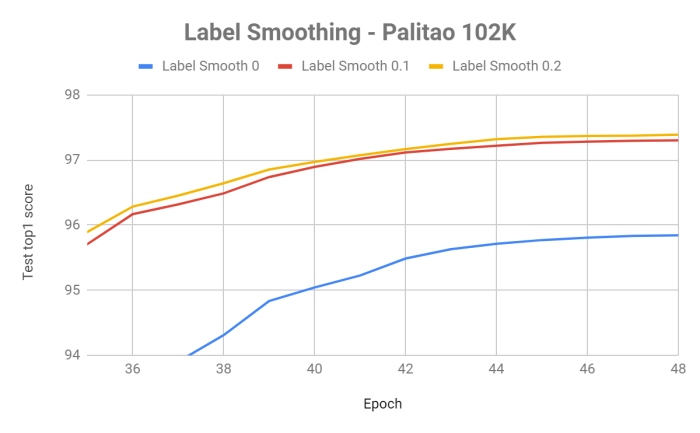
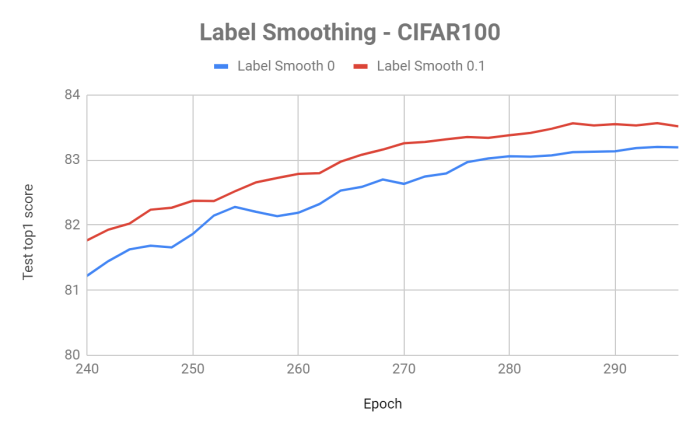
Hence we recommend using label smoothing for classification problems. This is especially important for datasets with a large number of labels.
We recommend doing checklist trials for 3 values of label smoothing: 0, 0.1, and 0.2.
It is a very common practice to govern a regularization technique by one (or more) fixed hyper-parameter values. However, for learning-rate it is clearly absurd to think that a fixed value is the optimum solution, and people always use a scheduling regime, usually decreasing the learning rate during the training. Why shouldn't we use similar scheduling regimes for regularization techniques?
An interesting question would be: should we increase or decrease regularization "power" during the training? Here is where we stand - overfitting happens toward the end of the training, when the learning rate is low and the model has almost fully converged. Hence we argue that we need to increase regularization strength as the training progresses, and prevent the overfitting at the final training stages.
Here is an example: we tested different values of weight decay on CIFAR100 dataset, and found very clearly that 3e-4 is the optimum value (for a fixed weight decay).
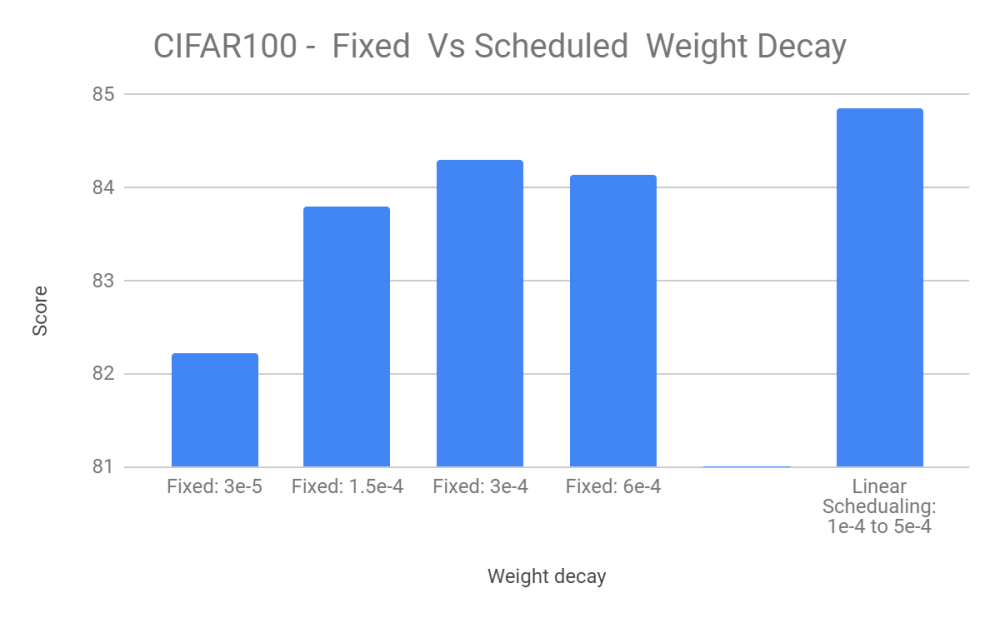
A simple test with scheduled weight decay, where we linearly increase its value during the training, immediately gave improvement over the best fixed-value option:
We are still researching other scheduling schemes - for example, instead of changing a regularization factor linearly (linear policy), we can increase it after each learning cycle (cycles policy), or make it proportional to the learning rate (learning rate policy):
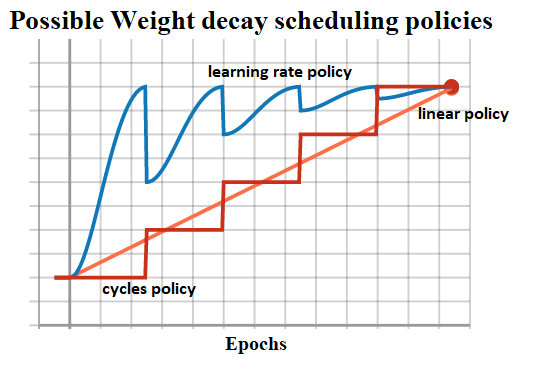
For now, we recommend that once you established an optimal value for (fixed) weight decay, compare it against linear scheduled weight decay regime, summing up to 2 trials.
Mixup technique was suggested in Facebook article "mixup: Beyond empirical risk minimization" and gained some popularity since. We followed the article implementation of mixup:

These are the results we got when testing mixup on 3 classification datasets:
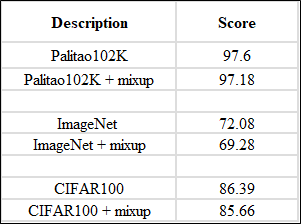
We can see that on all the datasets we didn't get any improvement from mixup.
In addition to these direct comparative runs, we also tried mixup with a variety of changes and adjustments:
Still, none of the runs surpass the baseline run - no mixup.
These are frustrating results, that are encountered a lot in deep learning - someone claims to have a dark magic novelty, and shows improved results in his repository. When importing his novelty to your own repository, no improvement is seen!
However, don't forget that regularization tricks need to work together. Sometimes a specific mix of regularization techniques works, and sometimes not. Maybe there is an inner "competition" between the techniques, where a specific regularization can fill the place of another.
In addition, specifically for mixup, the articles that claim to see improvements from it usually tested it on large models like Resnet50, which have tens of millions of parameters. The models we tested were lighter, with only ~5M params. Same as pretraining on ImageNet, it might be that mixup works better for larger models. We shall investigate it in the future.
Hence we recommend comparing your testing scores without and with mixup, summing up to 2 trials. Don't be alarmed if you don't see improvement. We didn't.
SE layers are architectural units that adaptively recalibrates channel-wise feature responses by explicitly modeling interdependencies between channels.
An example of SE block implementation can be written as:
def se_block(in_block, ch, ratio=16):
x = GlobalAveragePooling2D()(in_block)
x = Dense(ch//ratio, activation='relu')(x)
x = Dense(ch, activation='sigmoid')(x)
return multiply()([in_block, x])We highly recommend trying to add SE layers to any existing architecture: they are very simple, have low computational cost, and in most cases will give a nice boost to testing score, as the following runs demonstrate:
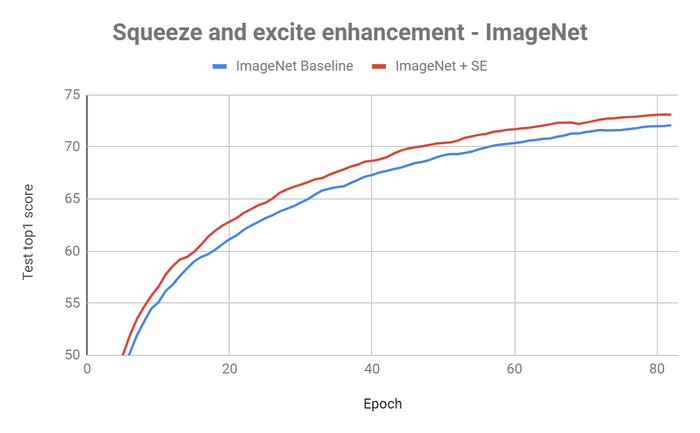
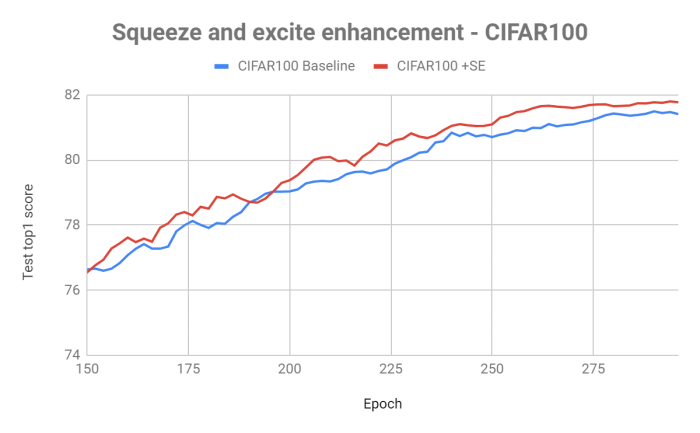
We recommend trying adding SE layers to any network backbone. Testing your architecture with and without SE layers will sum up to 2 trials.
Nowadays, Relu is used almost always as the activation function for every layer in deep learning networks.
This practice hasn't changed much in the last couple of years, and maybe better usage of activation functions is the edge your model needs to surpass the competitors and get top scores!
For ImageNet and other datasets, we usually place at the beginning of the network layers, with convolutions of stride 2, for downscaling the input.
We found that for those downscaling layers, using more "advanced" activation function, such as Leaky-Relu, Elu or Swish, significantly and consistently improves results:
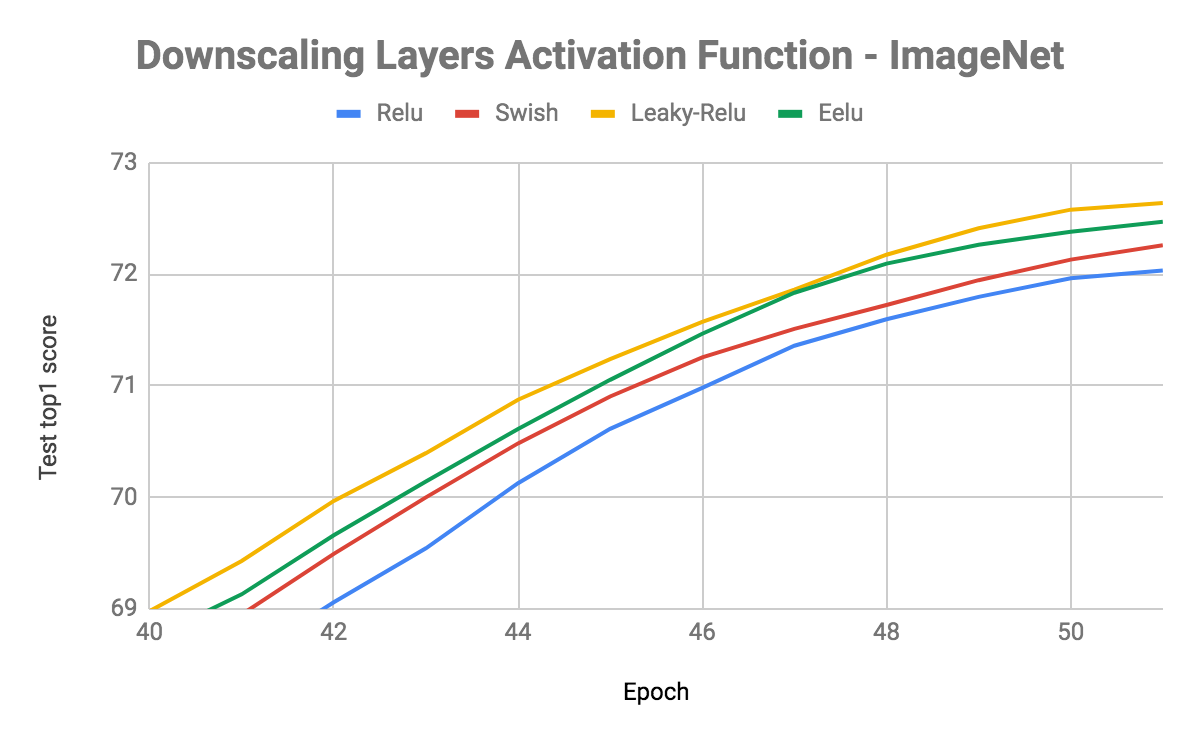
We speculate that unlike Relu, the newer activation functions allow (some) data flowing even for x<0, hence they work better for downscaling layers where we usually compress the data.
Leaky-Relu has significantly less computational cost than Elu or Swish. Hence, our recommendation is to use Leaky-Relu instead of plain Relu as the default activation layer of downscaling layers.
Testing your downscaling layers with Leaky-Relu, Relu and Swish will sum up to 3 trials.
In this article we have compiled a generic checklist of dark magic tricks, that can be used to upgrade any existing deep learning repository. We reviewed each trick and tried to offer insights, examples, and best practices.
Our recommend default baseline settings are the following:
Compared to the baseline scheme, for optimizing a repository we propose to do 15 checklist runs:
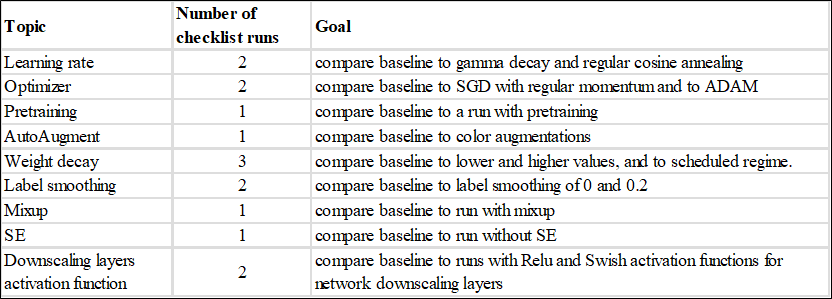
Note that the testing scheme we suggest can be paralleled, and all 15 runs can be done simultaneously. Also, if you want to reduce the number of runs, use the default options for some of the tricks.
An underlying assumption of our methodology is that the tricks are independent, and can be optimized separately (first-order approximation). This is not necessarily true, and it is probable that jointly optimizing several tricks will give better scores. However, direct joint optimization will increase the number of runs dramatically, reduce the ability to parallelize and make the whole process less feasible.
We are currently working on ways to enable tricks joint optimization and increase the automatization level of the checklist processing while keeping the number of runs reasonable.
Note that we chose to leave the following dark magic tricks to future posts:
These tricks are also important, and we recommend to optimize them in the same "checklist" manner that we proposed above.
AspectD: An Effective AOP Solution for Flutter——Open Sourced by Alibaba Xianyu Tech Team
15 posts | 1 followers
FollowAlibaba Clouder - September 1, 2020
Alibaba Clouder - September 20, 2019
Alibaba Cloud Security - December 12, 2019
Alibaba F(x) Team - October 8, 2021
chuan - February 27, 2020
Farruh - February 19, 2024
15 posts | 1 followers
Follow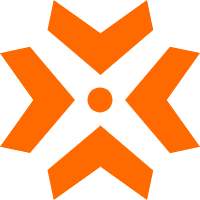 AIRec
AIRec
A high-quality personalized recommendation service for your applications.
Learn More Artificial Intelligence Service for Conversational Chatbots Solution
Artificial Intelligence Service for Conversational Chatbots Solution
This solution provides you with Artificial Intelligence services and allows you to build AI-powered, human-like, conversational, multilingual chatbots over omnichannel to quickly respond to your customers 24/7.
Learn More Alibaba Cloud Model Studio
Alibaba Cloud Model Studio
A one-stop service platform for whole-process generative AI engineering and application development, based on Tongyi Qianwen (Qwen) and other popular models
Learn More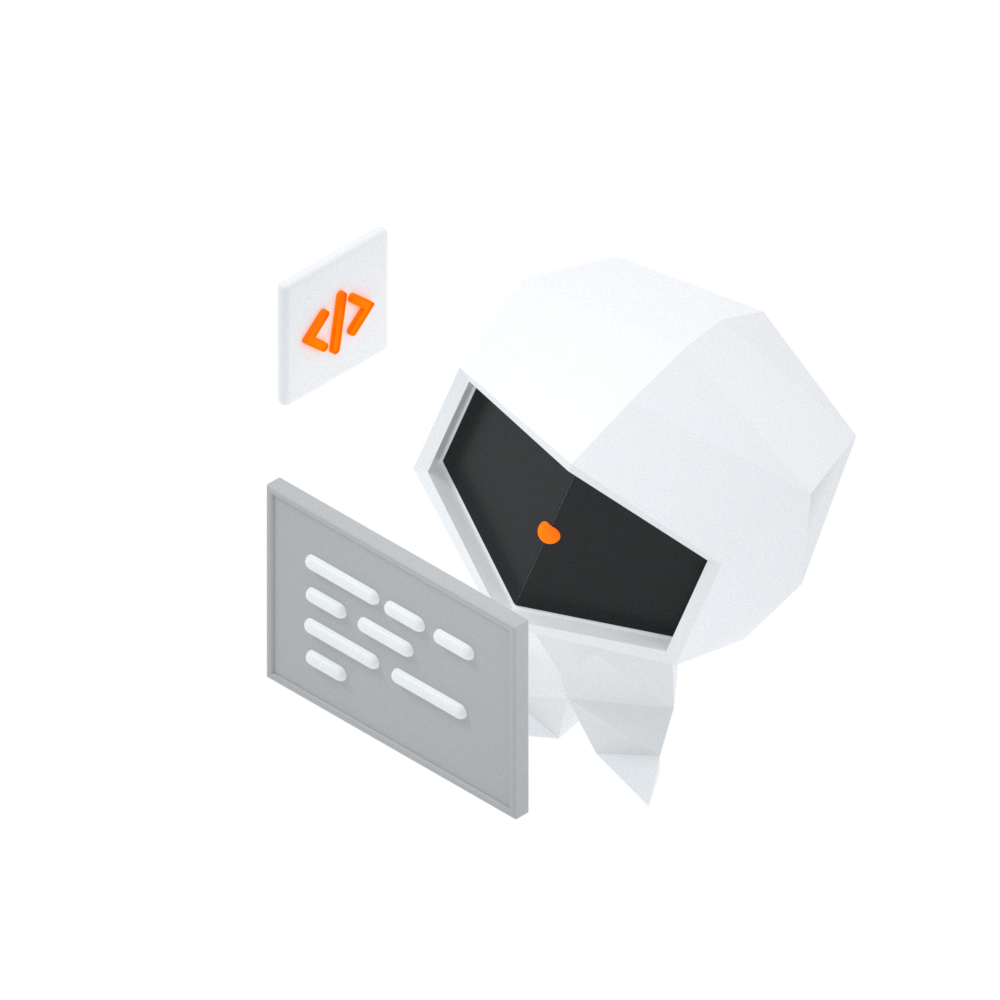 Log Management for AIOps Solution
Log Management for AIOps Solution
Log into an artificial intelligence for IT operations (AIOps) environment with an intelligent, all-in-one, and out-of-the-box log management solution
Learn MoreMore Posts by Alibaba Tech